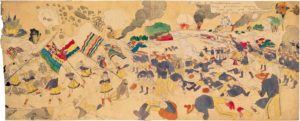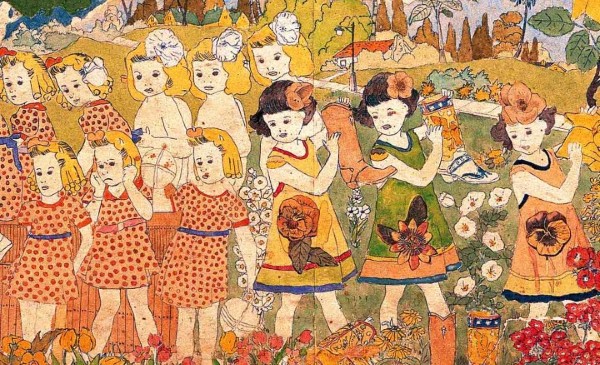 By Nancy Sims, Class of 2015, and Anne Shillinglaw, Class of 2015
By Nancy Sims, Class of 2015, and Anne Shillinglaw, Class of 2015
Co-Tour Directors, Sheffield Historic District
Editor’s note: This is a corrected version of the story posted earlier. The editors regret the error.
Most Chicago neighborhoods have their special “characters,” and Historic Sheffield, rich in Chicago history and stellar architecture dating from the 1870s, definitely meets that description. Henry Darger, a posthumously-famous Outsider Artist (artists without formal training/education) and longtime resident on Sheffield’s Webster Street, had a tragic, abused childhood living in a downstate asylum. He ran away from the institution, eventually coming to Chicago, where he would attend mass four times a day at St. Vincent DePaul Church. For years he lived a meager existence working as a janitor, dishwasher, and bandage roller in neighborhood hospitals. While renting a single room in a boarding house, he soon became an inveterate hoarder.
Darger collected magazines, pamphlets, coloring and picture books from alleys and garbage cans, etc. He then used the clippings from those found items to form his Vivian Girl collages and drawings. Only with his death in 1973 was Henry Darger’s artistic genius discovered in the form of two manuscripts: the 15,000-page The Story of the Vivian Girls, in what Is Known as the Realms of the Unreal, of the Glandeco-Angelinian War Storm, Caused by the Child Slave Rebellion, and a 5,000-page sequel, Further Adventures in Chicago.

Darger’s recurring themes, sometimes violent, depicted anatomically graphic children running from, as well as fighting pitched battles between good (children) and evil (adults). These scenes often referenced his own experiences at the Asylum for Feeble Minded Children in Lincoln, Il. But his art allowed him to become Capt. Henry Darger, vanquishing the enemy, as he led the “charge” of the Vivian Girls.
Subsequent to Darger’s death, the two manuscripts and additional artworks were discovered by Darger’s landlord, Nathan Lerner, and his wife Kiyoko when they cleaned out his rented room. The Lerners immediately recognized Darger’s talent. They called several curators, and eventually there was an exhibit in 1977 at the Hyde Park Art Center.
Fast forward several decades: Darger is now recognized as among THE leading Outsider Artists, and much favored by collectors around the world. Indeed, a panel of his work now sells for as much as $800,000. Major US and international museums and galleries are among the collectors owning or exhibiting Darger’s work and include: New York’s MOMA, as well as the American Folk Art Museum and the Whitney; Chicago’s Art Institute; the Milwaukee Art Museum; the Smithsonian; Collection de l’Art Brut, Lausanne, Switzerland; and Musee d’Art Moderne de la Ville de Paris.

For Chicagoans, the Intuit Museum on Milwaukee Avenue might be the preferred place to gain an interesting perspective, as the Intuit occasionally displays a re-creation of Darger’s one-room living space, along with many of his possessions.
In a final O.Henry story-like twist, Henry Darger is again featured in headlines, including national newspapers, art publications, and legal journals. When he died, penniless and unknown, he left no instructions regarding his possessions; there was no will, nor mention of who had the rights to his art. Darger’s landlords, the Lerners, claimed ownership, citing their “rescue” of Darger’s creations. More recently, Kiyoko Lerner points to her successful promotion of Darger’s work as having contributed to his now-legendary status.

However, with all the press and notoriety, distant family members of Henry Darger have now come forward, claiming their inheritance rights. Resulting court battles have yet to be concluded, as does the question of who owns the copyright to Henry Darger’s work. No surprise, legal scholars are weighing in as well as the Darger case, with all of its complexities, numerous claimants, and explosive value is shining a light on copyright law.
Henry Darger’s tombstone in All Saints Cemetery, Des Plaines, Il. reads: Henry Darger, Artist, 1892-1973
Sheffield Historic District is a neighborhood tour offered May-November:
Historic Sheffield is long considered a gem of late-19th century architecture. Neighborhood streets are lined with gorgeous homes from that era and beyond. Also noteworthy are the three streets of Rowhouse Districts from the 1870s and ‘80s, each of them landmarked by the City. The 90-minute tour weaves together stories of neighborhood characters and demographic change, while also highlighting the architectural styles that make the neighborhood unique.
Resources:
http://officialhenrydarger.com/collections/
“A Henry Darger Dispute: Who Inherits the Rights to a Loner’s Genius,” The New York Times, Robin Pogrebin, 2/8/22
“Hearing on Henry Darger Estate Dispute is Postponed,” The New York Times, Robin Pogrebin, 2/23/22
“’Outsider Artists’ and Inheritance Law: What Happens to an Artist’s Work when They Die Without a Will?,” Center for Art Law, Wenni Iben 11/11/22
“He was Crazy Like A Genius: For Henry Darger, Everything Began and Ended with Little Girls,” New York Times, Sept. 16, 2000, Sarah Boxersept
https://www.invaluable.com/artist/darger-henry-q46868kpep/sold-at-auction-prices/
https://www.moma.org/search/?bucket=2&query=henry+darger
Henry Darger, Throwaway Boy: The Tragic Life of an Outsider Artist, Jim Elledge, 2013
______________________________________________________________________________________________

CLICK HERE for more stories on The Bridge.


Thanks very much, Nancy and Anne, for this fascinating account!
The legal dispute over Darger’s works is reminiscent of the long disputes over the rights to photographer Vivian Maier’s works – in fact the first NYT article you cite, above, points out that “The Darger relatives — most of them first cousins twice or three times removed — were recently tracked down by Ron Slattery, who helped discover the work of Vivian Maier, a nanny and street photographer whose estate was similarly disputed by family members and has yet to be settled. … ”
As usual, lawyers make “intellectual property” arguments a complicated mess. The origin of U.S. copyright. Article 1 Section 8 Clause 8 of the Constitution: “The Congress shall have Power To … promote the Progress of Science and useful Arts, by securing for limited Times to Authors and Inventors the exclusive Right to their respective Writings and Discoveries” clearly means that it is public benefits, not greedy relatives, that are to be protected, and SCOTUS in the past has agreed that is the case.
Thank you for this update on what has happened since he passed away.
Fascinating stuff. Thanks for telling the story of an artist I had only barely heard of. Is Darger’s room in the Sheffield district?
Great article. Thanks for telling his story.